初中英语重要句型用法总结
- 格式:pdf
- 大小:71.13 KB
- 文档页数:12
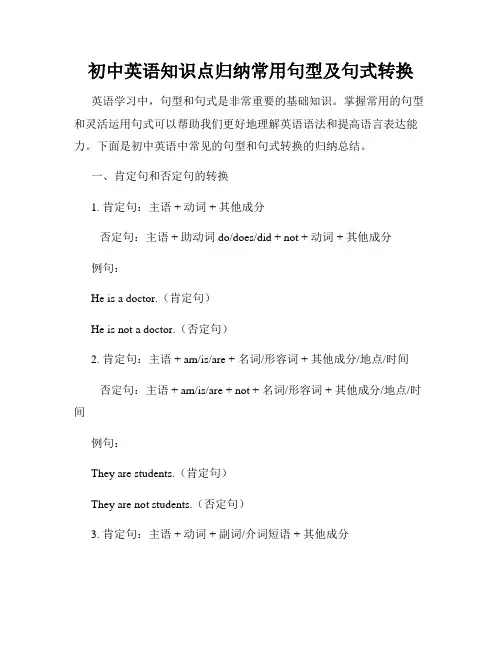
初中英语知识点归纳常用句型及句式转换英语学习中,句型和句式是非常重要的基础知识。
掌握常用的句型和灵活运用句式可以帮助我们更好地理解英语语法和提高语言表达能力。
下面是初中英语中常见的句型和句式转换的归纳总结。
一、肯定句和否定句的转换1. 肯定句:主语 + 动词 + 其他成分否定句:主语 + 助动词 do/does/did + not + 动词 + 其他成分例句:He is a doctor.(肯定句)He is not a doctor.(否定句)2. 肯定句:主语 + am/is/are + 名词/形容词 + 其他成分/地点/时间否定句:主语 + am/is/are + not + 名词/形容词 + 其他成分/地点/时间例句:They are students.(肯定句)They are not students.(否定句)3. 肯定句:主语 + 动词 + 副词/介词短语 + 其他成分否定句:主语 + 助动词 do/does/did + not + 动词 + 副词/介词短语 + 其他成分例句:She speaks English fluently.(肯定句)She does not speak English fluently.(否定句)二、一般疑问句和特殊疑问句的转换1. 一般疑问句:肯定句:Do/Does/Did + 主语 + 动词 + 其他成分?否定句:Do/Does/Did + 主语 + 动词 + not + 其他成分?特殊疑问句:疑问词 + 一般疑问句的语序例句:She goes to school by bus.(一般疑问句)Does she go to school by bus?(特殊疑问句)2. 一般疑问句:肯定句:Am/Is/Are + 主语 + 名词/形容词 + 其他成分/地点/时间?否定句:Am/Is/Are + 主语 + not + 名词/形容词 + 其他成分/地点/时间?特殊疑问句:疑问词 + 一般疑问句的语序例句:They are students.(一般疑问句)Are they students?(特殊疑问句)3. 一般疑问句:肯定句:助动词 + 主语 + 动词 + 副词/介词短语 + 其他成分?否定句:助动词 + Do/Does/Did + 主语 + 动词 + not + 副词/介词短语 + 其他成分?特殊疑问句:疑问词 + 一般疑问句的语序例句:He speaks English fluently.(一般疑问句)Does he speak English fluently?(特殊疑问句)三、陈述句和祈使句的转换1. 陈述句:主语 + 动词 + 其他成分祈使句:动词 + 其他成分(一般省略主语 you)例句:They play football.(陈述句)Play football.(祈使句)2. 陈述句:主语 + am/is/are + 名词/形容词 + 其他成分/地点/时间祈使句:Be + 名词/形容词 + 其他成分/地点/时间例句:You are a student.(陈述句)Be a student.(祈使句)3. 陈述句:主语 + 动词 + 副词/介词短语 + 其他成分祈使句:动词 + 副词/介词短语 + 其他成分例句:She speaks English fluently.(陈述句)Speak English fluently.(祈使句)通过以上的归纳总结,我们可以更好地理解和运用常用的句型和句式转换。
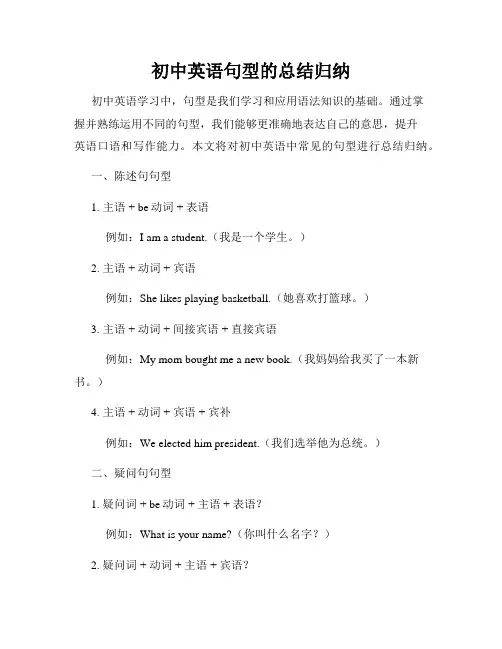
初中英语句型的总结归纳初中英语学习中,句型是我们学习和应用语法知识的基础。
通过掌握并熟练运用不同的句型,我们能够更准确地表达自己的意思,提升英语口语和写作能力。
本文将对初中英语中常见的句型进行总结归纳。
一、陈述句句型1. 主语 + be动词 + 表语例如:I am a student.(我是一个学生。
)2. 主语 + 动词 + 宾语例如:She likes playing basketball.(她喜欢打篮球。
)3. 主语 + 动词 + 间接宾语 + 直接宾语例如:My mom bought me a new book.(我妈妈给我买了一本新书。
)4. 主语 + 动词 + 宾语 + 宾补例如:We elected him president.(我们选举他为总统。
)二、疑问句句型1. 疑问词 + be动词 + 主语 + 表语?例如:What is your name?(你叫什么名字?)2. 疑问词 + 动词 + 主语 + 宾语?例如:Where did you go last night?(你昨晚去哪里了?)3. 特殊疑问句:疑问词 + 动词 + 其他成分 + 一般疑问句?例如:How many books do you have?(你有多少本书?)三、否定句句型1. 主语 + do/does/did + not + 动词原形例如:I do not like swimming.(我不喜欢游泳。
)2. 主语 + be动词 + not + 表语例如:He is not a doctor.(他不是医生。
)四、祈使句句型1. 动词原形 + 宾语例如:Open the window.(打开窗户。
)2. Let + 宾语 + 动词原形例如:Let me help you.(让我来帮你。
)五、感叹句句型1. What + a/an + 形容词 + 名词 + 主语 + 动词!例如:What a beautiful flower it is!(多么漂亮的花啊!)2. How + 形容词/副词 + 主语 + 动词!例如:How fast he runs!(他跑得多快啊!)六、条件句句型1. if + 现在时态,将来时态例如:If it rains, we will stay at home.(如果下雨,我们会呆在家里。
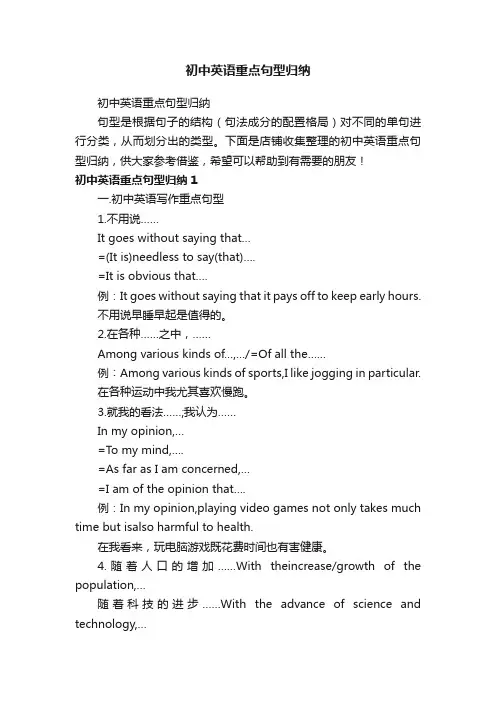
初中英语重点句型归纳初中英语重点句型归纳句型是根据句子的结构(句法成分的配置格局)对不同的单句进行分类,从而划分出的类型。
下面是店铺收集整理的初中英语重点句型归纳,供大家参考借鉴,希望可以帮助到有需要的朋友!初中英语重点句型归纳1一.初中英语写作重点句型1.不用说……It goes without saying that…=(It is)needless to say(that)….=It is obvious that….例:It goes without saying that it pays off to keep early hours.不用说早睡早起是值得的。
2.在各种……之中,……Among various kinds of…,…/=Of all the……例︰Among various kinds of sports,I like jogging in particular.在各种运动中我尤其喜欢慢跑。
3.就我的看法……;我认为……In my opinion,…=To my mind,….=As far as I am concerned,…=I am of the opinion that….例:In my opinion,playing video games not only takes much time but isalso harmful to health.在我看来,玩电脑游戏既花费时间也有害健康。
4.随着人口的增加……With theincrease/growth of the population,…随着科技的进步……With the advance of science and technology,…例:With the rapid development of Taiwan’s economy,a lot ofsocial problems have come to pass.随着台湾经济的快速发展许多社会问题产生了。
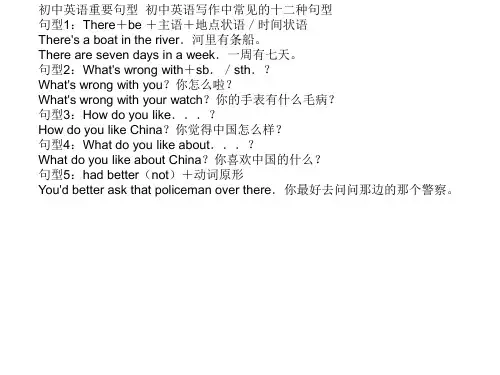
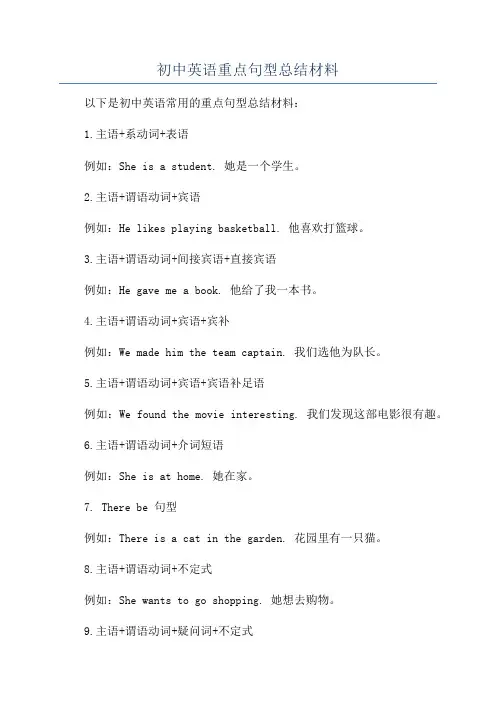
初中英语重点句型总结材料以下是初中英语常用的重点句型总结材料:1.主语+系动词+表语例如:She is a student. 她是一个学生。
2.主语+谓语动词+宾语例如:He likes playing basketball. 他喜欢打篮球。
3.主语+谓语动词+间接宾语+直接宾语例如:He gave me a book. 他给了我一本书。
4.主语+谓语动词+宾语+宾补例如:We made him the team captain. 我们选他为队长。
5.主语+谓语动词+宾语+宾语补足语例如:We found the movie interesting. 我们发现这部电影很有趣。
6.主语+谓语动词+介词短语例如:She is at home. 她在家。
7. There be 句型例如:There is a cat in the garden. 花园里有一只猫。
8.主语+谓语动词+不定式例如:She wants to go shopping. 她想去购物。
9.主语+谓语动词+疑问词+不定式例如:Can you tell me how to get to the library? 你可以告诉我怎么去图书馆吗?10. 主语 + 谓语动词 + 动词-ing形式例如:I enjoy swimming. 我喜欢游泳。
11. 主语 + 谓语动词 + 宾语 + 动词-ing形式例如:He saw them playing basketball. 他看见他们在打篮球。
12.主语+谓语动词+不定式+宾语例如:He wants me to help him. 他想让我帮助他。
13.主语+谓语动词+宾语+不定式例如:We made him study harder. 我们逼他更加努力学习。
14. It is + 形容词 + (for sb.) + to do例如:It's important for us to learn English well. 学好英语对我们来说很重要。
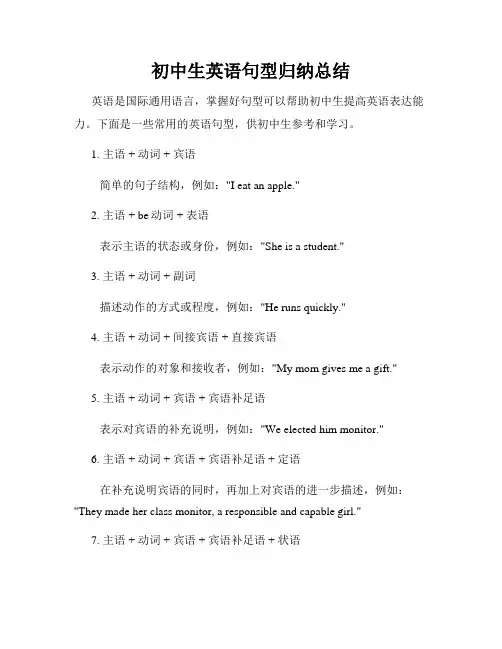
初中生英语句型归纳总结英语是国际通用语言,掌握好句型可以帮助初中生提高英语表达能力。
下面是一些常用的英语句型,供初中生参考和学习。
1. 主语 + 动词 + 宾语简单的句子结构,例如:"I eat an apple."2. 主语 + be动词 + 表语表示主语的状态或身份,例如:"She is a student."3. 主语 + 动词 + 副词描述动作的方式或程度,例如:"He runs quickly."4. 主语 + 动词 + 间接宾语 + 直接宾语表示动作的对象和接收者,例如:"My mom gives me a gift."5. 主语 + 动词 + 宾语 + 宾语补足语表示对宾语的补充说明,例如:"We elected him monitor."6. 主语 + 动词 + 宾语 + 宾语补足语 + 定语在补充说明宾语的同时,再加上对宾语的进一步描述,例如:"They made her class monitor, a responsible and capable girl."7. 主语 + 动词 + 宾语 + 宾语补足语 + 状语在补充说明宾语的同时,再加上对动作的方式或程度的描述,例如:"The teacher found her homework, carefully and neatly done."8. 主语 + 动词 + 宾语 + 状语用来描述动作的方式或程度,例如:"I read books every day."9. 主语 + 动词 + 介词短语表示动作发生的地点或方向,例如:"He walked to the park."10. 主语 + 动词 + 间接宾语 + 直接宾语 + 状语在表达动作对象和接收者的同时,还加上对动作的方式或程度的描述,例如:"My teacher gave me a big hug warmly."11. 主语 + 助动词 + be动词 + 宾语表示对宾语的肯定或否定,例如:"She is not my sister."12. There be句型用来表示存在或发生的情况,例如:"There is a book on the desk."13. if条件句表示假设或条件,例如:"If it rains, we will stay at home."14. 主语 + 情态动词 + 动词原形表示能力、权利、义务等情态,例如:"You should study hard."15. 主语 + 情态动词 + be动词 + 宾语表示推测或可能性,例如:"He might be at home."以上是一些常用的英语句型,初中生可以根据需要进行运用。
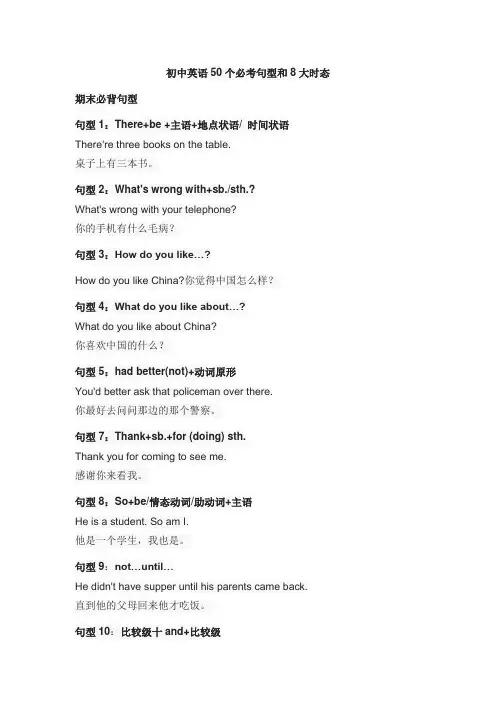
初中英语50个必考句型和8大时态期末必背句型句型1:There+be +主语+地点状语/ 时间状语There're three books on the table.桌子上有三本书。
句型2:What's wrong with+sb./sth.?What's wrong with your telephone?你的手机有什么毛病?句型3:How do you like…?How do you like China?你觉得中国怎么样?句型4:What do you like about…?What do you like about China?你喜欢中国的什么?句型5:had better(not)+动词原形You'd better ask that policeman over there.你最好去问问那边的那个警察。
句型7:Thank+sb.+for (doing) sth.Thank you for coming to see me.感谢你来看我。
句型8:So+be/情态动词/助动词+主语He is a student. So am I.他是一个学生,我也是。
句型9:not…until…He didn't have supper until his parents came back.直到他的父母回来他才吃饭。
句型10:比较级十and+比较级The baby cried harder and harder.那孩子哭得越来越厉害。
句型11:the+比较级,the+比较级The more one has,the more one wants.拥有的越多,想要的越多。
句型12:…as+adj./adv.+as……not as(so)+adj./adv.+as…Last Sunday the weather was not so wet as it is today.上个星期天的天气不如今天的天气潮湿。
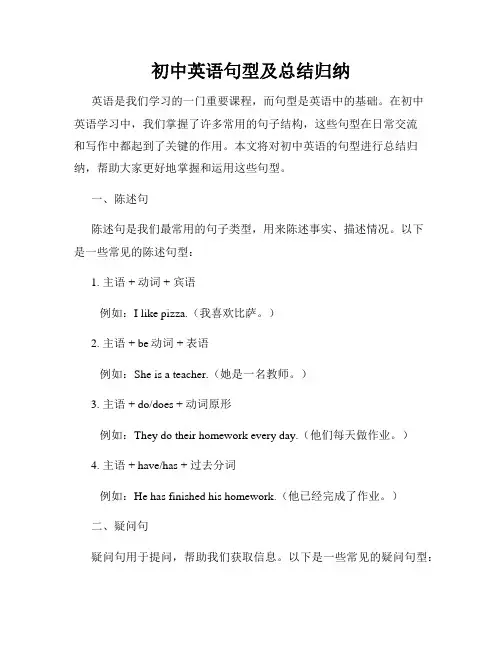
初中英语句型及总结归纳英语是我们学习的一门重要课程,而句型是英语中的基础。
在初中英语学习中,我们掌握了许多常用的句子结构,这些句型在日常交流和写作中都起到了关键的作用。
本文将对初中英语的句型进行总结归纳,帮助大家更好地掌握和运用这些句型。
一、陈述句陈述句是我们最常用的句子类型,用来陈述事实、描述情况。
以下是一些常见的陈述句型:1. 主语 + 动词 + 宾语例如:I like pizza.(我喜欢比萨。
)2. 主语 + be动词 + 表语例如:She is a teacher.(她是一名教师。
)3. 主语 + do/does + 动词原形例如:They do their homework every day.(他们每天做作业。
)4. 主语 + have/has + 过去分词例如:He has finished his homework.(他已经完成了作业。
)二、疑问句疑问句用于提问,帮助我们获取信息。
以下是一些常见的疑问句型:1. 疑问词 + 助动词 + 主语 + 动词?例如:What do you like?(你喜欢什么?)2. 助动词 + 主语 + 动词?例如:Do you play basketball?(你打篮球吗?)3. 特殊疑问句例如:Where did you go yesterday?(你昨天去哪里了?)三、祈使句祈使句用于表达请求、命令或建议。
以下是一些常见的祈使句型:1. 动词原形 + 其他成分例如:Open the window, please.(请打开窗户。
)2. 动词原形 + 不定代词/名词例如:Eat some fruit.(吃些水果。
)四、感叹句感叹句用于表达惊讶、赞美、喜悦等情感。
以下是一些常见的感叹句型:1. How + 形容词/副词 + 主语 + 动词!例如:How beautiful the flowers are!(花儿多美啊!)2. What + 形容词 + 名词 + 主语 + be动词!例如:What a lovely dog he has!(他有一只多可爱的狗啊!)五、条件句条件句用于表达假设、条件和结果之间的关系。
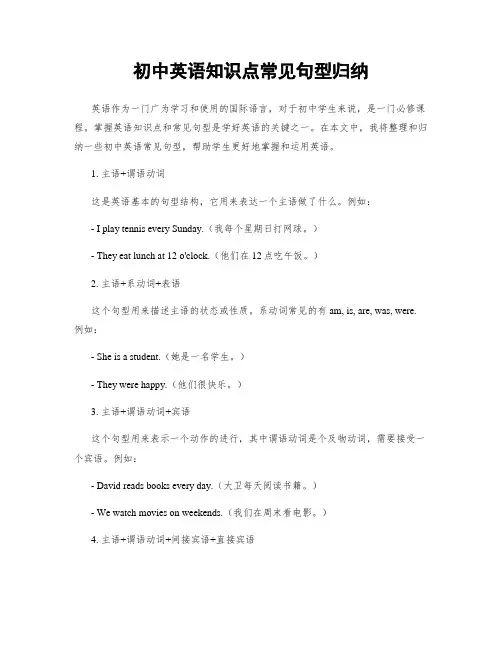
初中英语知识点常见句型归纳英语作为一门广为学习和使用的国际语言,对于初中学生来说,是一门必修课程。
掌握英语知识点和常见句型是学好英语的关键之一。
在本文中,我将整理和归纳一些初中英语常见句型,帮助学生更好地掌握和运用英语。
1. 主语+谓语动词这是英语基本的句型结构,它用来表达一个主语做了什么。
例如:- I play tennis every Sunday.(我每个星期日打网球。
)- They eat lunch at 12 o'clock.(他们在12点吃午饭。
)2. 主语+系动词+表语这个句型用来描述主语的状态或性质。
系动词常见的有 am, is, are, was, were. 例如:- She is a student.(她是一名学生。
)- They were happy.(他们很快乐。
)3. 主语+谓语动词+宾语这个句型用来表示一个动作的进行,其中谓语动词是个及物动词,需要接受一个宾语。
例如:- David reads books every day.(大卫每天阅读书籍。
)- We watch movies on weekends.(我们在周末看电影。
)4. 主语+谓语动词+间接宾语+直接宾语这个句型使用于在谓语动词后面有两个宾语的情况。
间接宾语通常是人,直接宾语是物。
例如:- My mother bought me a new backpack.(我妈妈给我买了一个新背包。
)- The teacher gave the students a test.(老师给学生们一张考试卷。
)5. 主语+谓语动词+宾补这个句型使用于谓语动词需要接补语来构成完整含义的情况。
宾补通常是形容词、名词或动词不定式。
例如:- We elected him class monitor.(我们选他为班长。
)- They made the room clean and tidy.(他们把房间打扫得干净整洁。
)6. 主语+及物动词+间接宾语+直接宾语+宾补这个句型使用于在及物动词后面有两个宾语并且需要宾补的情况。
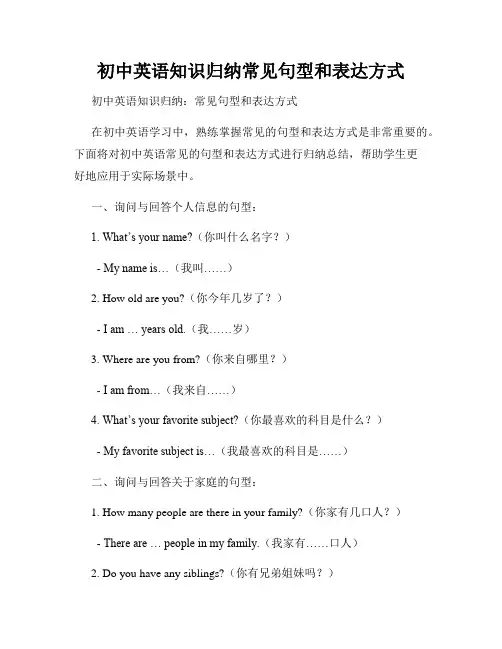
初中英语知识归纳常见句型和表达方式初中英语知识归纳:常见句型和表达方式在初中英语学习中,熟练掌握常见的句型和表达方式是非常重要的。
下面将对初中英语常见的句型和表达方式进行归纳总结,帮助学生更好地应用于实际场景中。
一、询问与回答个人信息的句型:1. What’s your name?(你叫什么名字?)- My name is…(我叫……)2. How old are you?(你今年几岁了?)- I am … years old.(我……岁)3. Where are you from?(你来自哪里?)- I am from…(我来自……)4. What’s your favorite subject?(你最喜欢的科目是什么?)- My favorite subject is…(我最喜欢的科目是……)二、询问与回答关于家庭的句型:1. How many people are there in your family?(你家有几口人?)- There are … people in my family.(我家有……口人)2. Do you have any siblings?(你有兄弟姐妹吗?)- Yes, I have … siblings.(是的,我有……个兄弟姐妹)3. What does your father/mother do?(你爸爸/妈妈是做什么的?)- My father/mother is a…(我爸爸/妈妈是一个……)4. Where do you live?(你住在哪里?)- I live in…(我住在……)三、询问与回答关于学校的句型:1. What grade are you in?(你在几年级?)- I am in Grade…(我在……年级)2. What’s your favorite subject?(你最喜欢的科目是什么?)- My favorite subject is…(我最喜欢的科目是……)3. Who is your favorite teacher?(你最喜欢的老师是谁?)- My favorite teacher is …(我最喜欢的老师是……)4. What do you usually do at school?(你通常在学校做什么?)- I usually study, play sports, and hang out with my friends.(我通常学习、进行体育运动并和朋友们一起玩耍)四、询问与回答关于兴趣爱好的句型:1. What do you like to do in your free time?(你在空闲时间喜欢做什么?)- I like to…(我喜欢……)2. Do you play any musical instruments?(你会弹奏乐器吗?)- Yes, I play…(是的,我弹奏……)3. What sports do you enjoy?(你喜欢什么运动?)- I enjoy…(我喜欢……)4. Do you have any hobbies?(你有什么爱好吗?)- Yes, my hobbies are…(是的,我的爱好是……)五、询问与回答关于日常活动的句型:1. What time do you usually get up?(你通常几点起床?)- I usually get up at…(我通常在……点起床)2. What time do you go to bed?(你几点睡觉?)- I go to bed at…(我在……点睡觉)3. How do you go to school?(你怎么去学校?)- I go to school by…(我乘……去学校)4. What do you usually eat for breakfast/lunch/dinner?(你通常吃什么早餐/午餐/晚餐?)- I usually eat… for breakfast/lunch/dinner.(我通常吃……作为早餐/午餐/晚餐)通过以上的句型和表达方式归纳,使初中学生能够更好地应对日常对话及书面表达中的常见问题。
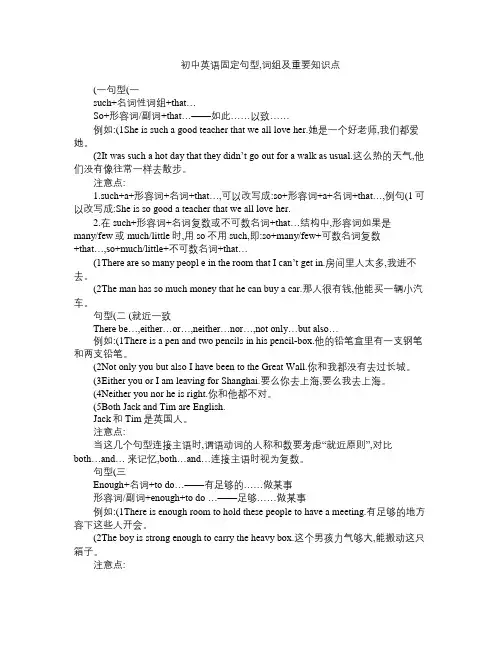
初中英语固定句型,词组及重要知识点(一句型(一such+名词性词组+that…So+形容词/副词+that…——如此……以致……例如:(1She is such a good teacher that we all love her.她是一个好老师,我们都爱她。
(2It was such a hot day that they didn’t go out for a walk as usual.这么热的天气,他们没有像往常一样去散步。
注意点:1.such+a+形容词+名词+that…,可以改写成:so+形容词+a+名词+that…,例句(1可以改写成:She is so good a teacher that we all love her.2.在such+形容词+名词复数或不可数名词+that…结构中,形容词如果是many/few或much/little时,用so不用such,即:so+many/few+可数名词复数+that…,so+much/little+不可数名词+that…(1There are so many peopl e in the room that I can’t g et in.房间里人太多,我进不去。
(2The man has so much money that he can buy a car.那人很有钱,他能买一辆小汽车。
句型(二 (就近一致There be…,either…or…,neither…nor…,not only…but also…例如:(1There is a pen and two pencils in his pencil-box.他的铅笔盒里有一支钢笔和两支铅笔。
(2Not only you but also I have been to the Great Wall.你和我都没有去过长城。
(3Either you or I am leaving for Shanghai.要么你去上海,要么我去上海。
初中英语知识点句型总结一、时态1. 一般现在时:表示经常发生的动作或现在的状态。
- 例句:She goes to school every day.2. 现在进行时:表示正在进行的动作。
- 例句:He is reading a book now.3. 一般过去时:表示过去发生的动作或状态。
- 例句:They visited the museum last week.4. 过去进行时:表示过去某个时间点正在进行的动作。
- 例句:She was watching TV when I called her.5. 一般将来时:表示将来会发生的动作或状态。
- 例句:I will travel to Japan next year.6. 现在完成时:表示过去发生的动作对现在造成的影响或结果。
- 例句:He has finished his homework.7. 现在完成进行时:表示从过去某时刻开始一直持续到现在的动作。
- 例句:She has been studying English for five years.二、语态1. 被动语态:表示动作的承受者。
- 例句:The book was written by the author.三、情态动词1. can/could:表示能力或许可。
- 例句:She can speak three languages.2. may/might:表示可能性或许可。
- 例句:It might rain later.3. must:表示必须或强烈推测。
- 例句:You must wear a seatbelt in the car.4. should:表示建议或应当。
- 例句:You should eat more vegetables.四、非谓语动词1. 动名词:作为名词使用,表示动作。
- 例句:Swimming is my favorite sport.2. 分词(现在分词和过去分词):作为形容词或副词使用。
初中英语重点句型总结重温重点句型1.So + be/助动词/情牵动词/主语.前面陈述的肯定情况也适于另一人(物)时,常用到这种倒装结构,表示“另一人(物)也如此。
”前面陈述的否定情况也适于另一人(物)时,常用“Neither/ Nor + be/助动词/情态动词+主语.”这种倒装结构。
例如:He likes playing basketball, and so do I.他喜欢打篮球,我也喜欢。
Kate can’t speak Chinese, and I neither/ nor can Jim.凯特不会说汉语。
吉姆也不会。
注意:“So+主语+be/助动词/情态动词.”这一句型常用于表示赞同,进一步肯定对方的看法,表示“的确如此。
”“是呀。
”例如:一Basketball is very popular game in America.篮球在美国是一项很受欢迎的运动。
一So it is.的确如此。
2.Turn right/left at the first/second/…crossing.这一指路的句型意为“在第一/二/……个十字路口向右/左拐。
”相当于Take the first /second/…turning on theright/left.例如:一Can you tell me the way to the nearest post office?你能告诉我去最近的邮局的路吗?一Walk along this road,and turn left at the third crossing.沿着这条路走,在第三个路口向左拐。
3.It takes sb.some time to do sth.此句型表示“干某事花了某人一段时间。
”其中的it是形式主语,后面的动词不定式(短语)才是真正的主语。
例如:It took me half an hour to finish the hard work.完成这项艰巨的工作花了我半个小时。
初中英语重要句型初中英语写作中常见的十二种句型句型1:There + be +主语+地点状语/时间状语There's a boat in the river .河里有条船。
There are seven days in a week .一周有七天。
句型2 : What's wrong with + sb . /sth . ?What's wrong with you 你怎么啦?What's wrong with your watch 你的手表有什么毛病?句型3 . How do you like . . . ?How do you like China 你觉得中国怎么样?句型4: What do you like about. . . ?What do you like about China 你喜欢中国的什么?句型5 : had better (not) +动词原形You'd better ask that policeman over there .你最好去问问那边的那个警察。
句型6 : How+adj. /adv. +主语+谓语!What a / an + adj . + n . + 主语 + i胃语!句型50 :• so that..Put the tree in the hole so that it is straight .把树放入洞穴中,让它立直。
句型51 : be + num . + metres / kilometres /years. . . + long/wide/deep/high/old...The Great Green Wall is 7 z 000 kilometres long .绿色长城长7000 公里。
The river is about 2 metres deep .这条:可大约有2 米深。
The boy is about 12 years old .这个男孩约12 岁。
与期中考试英语满分的距离,是这60个重要的句型!之邯郸勺丸创作初中60个重要的句型,希望对大家有帮忙!1.as…as和……一样中间必须用形容词或副词原级.例如:Thisclassroom is as big as that one.这间教室和那间一样大.Heruns as fast as Tom.他和汤姆跑的一样快.否认结构:not as/so…as,“不如……”.上面的两个句子可辨别改成:Thisclassroom is not as/so large as that one.这间教室不如那间大.Hedoesn’t run as/so fast as Tom.他跑得不如汤姆快.2.as soon as一……就……用来引导时间状语从句.若主句是一般将来时,从句要用一般现在时.例如:I’lltell him the plan as soon as I see him.我一看到他就告知他这个计划.He’llgo home as soon as he finishes his work.他一完成任务就回家.3.be busy/enjoy/hate/go on/finish doing sth.忙于/喜欢/讨厌/继续/完成做某事在enjoy,finish,hate,go on,be busy等词语后,一般用动词-ing形式作宾语.例如:LinTao is busy making a model plane.林涛正忙着做飞机模型.Mymother enjoys taking a walk after supper.我妈妈喜欢晚饭后散步.I hatewatching Channel Five.我讨厌看五频道.Whensomeone asked him to have a rest,he just went onworking.当有人让他休息一会儿时,他仍继续任务.I havefinished writing the story.我已经写完了故事.4.fill…with用……装满......;be filled with 充满了……;be full of充满了......①be filled with说明由外界事物造成的此种状态,暗示主动.例如:Thebox is filled with food.盒子里装满了食物.②be full of说明主语处于的状态.此外,还可暗示程度,意为“很是”.例如:Thepatient’s room is full of flowers.那个病人的房间摆满了花.Theyoung man is full of pride.那个年轻人很是骄傲.③这两种结构还可以相互改写.例如:I fillthe box with food.The box is full of food.5.be good/bad for有利于/有害于……此句型是:be+adj.+for+n.结构.例如:Doingmorning exercises is good for your health.做早操对你的健康有益.Alwaysplaying computer games is bad for your study.总玩电脑游戏对你的学习晦气.6.be used to(doing)sth.习惯于……后必须接名词或动名词,可用于现在、过去、将来的多种时态.be可用get,become来代替.例如:He isused to life in the country.(He is used to living inthe country.)他习惯于乡村生活.Hewill get used to getting up early.他将会习惯于早起.注意:be used to do的意思是“被用来做……”.例如:Woodis used to make paper.木材被用来造纸.7.both…and…两者都……用来连接两个并列成分;当连接两个并列主语时,其后谓语动词用单数.例如:Boththe students and the teachers will go to the HistoryMuseumtomorrow.不管老师还是学生明天都会去历史博物馆.8.can’t help doing sth.禁不住做某事help在此的意思是“抑制,忍住”,其后接动词-ing形式.例如:Hisjoke is too funny.We can’t help laughing.他的笑话太有趣了,我们禁不止笑了起来.9.sth.costs sb.some money某物花费某人多少钱此句型的主语是物.cost一词带的是双宾语,它的过去式、过去分词和原型一样.Thisbook cost me five yuan.这本书花了我五元钱.10.either…or…不是……就是……,或者……或者……用来连接两个并列成分,当连接并列主语时,谓语动词与邻近的主语坚持一致.Youmay either stay here or go home.你可以呆在这儿,也可以回家.Eithershe or I am right.=Either I or she is right.不是她对就是我对.11.enough(for sb.)to do sth.足够……做……在此结构中,for用来引出不定式的逻辑主语.例如:Theice isn’t thick enough for you to walk on.这冰还没有厚到你可以在上面走的程度.12.feel like doing sth.想要做……此处like 为介词,后面跟动词-ing形式.此句型与would like to dosth.同义.例如:I feellike drinking a cup of milk.我想喝一杯牛奶.13.feel/find/think it adj./n.to do sth.认为某事……在此结构中it为形式宾语,不定式短语作真正的宾语.例如:I findit very interesting to play football.我发明踢足球很有趣.Shethinks it her duty to help us.她认为帮忙我们是她的职责.14.get ready for sth./to do sth.Getready for sth.意为“为某事做准备”;getready to dosth.意为“准备做某事”例如:We aregetting ready for the meeting.我们正在为会议做准备.Theywere getting ready to have a sports meet at that moment.他们那时正准备开运动会.15.get/receive/have a letter from收到……的来信,相当于hear fromDidyou receive a letter from John?你收到约翰的来信了吗?I gota letter from my brother yesterday.我昨天收到了我弟弟的一封来信.16.hadbetter(not)do sth.最好(别)做某事hadbetter为情态动词,其后需用动词原形.had better经常使用缩写,酿成’d better,其否认形式是在其后直接加not.例如:We hadbetter go no w.=We’d better go now.我们最好现在走吧.You’dbetter not go out because it is windy.今天起风,你最好别出去了.17.havesth.done使(某事)完成(动作由他人完成)sth.为宾语,done为过去分词作补语.例如:We hadthe machine repaired.我们请人把机器修好了.注意区分:We haverepaired the machine.我们(自己)已经修好了机器.18.help sb.(to)do sth./with sth.帮忙某人(做)某事,其中的to可以省略.例如:Ioften help my mother with housework.我经常帮忙妈妈做家务.Wouldyou please help me(to)look up these words?请你帮忙我查查这些词好吗?19.How do you like……?你认为……怎么样?与what do you think of…?同义.例如:How doyou like the weather in Beijing?你认为北京的天气怎么样?你觉得这部新电影如何?20.I don’t think/believethat…我认我/相信……不……其中的not是对宾语从句进行否认而不是对主句否认(否认前移).that可省略.例如:Idon’t think it will rain.我认为天不会下雨.Idon’t believe the girl will come.我相信那女孩不会来了.21.It happens that…碰巧……相当于happen to do例如:Ithappened that I heard their secret.可改写为:I happened tohear their secret.我碰巧听到了他们的秘密.22.It’s/has been+一段时间+since从句自从某时起做某件事情已经一段时间了该句型中since引导的时间状语从句经常使用一般过去时.例如:It’s twentyyears since he came here.他来这里已经20年了.It hasbeen six years since he married Mary.他和玛丽结婚已经六年了.23.It is+adj./n.+for sb.to do sth.做某事对某人来说……It是形式主语,真正的主语是不定式todo sth.例如:It’snot easy for us to study English well.对我们来说学好英语其实不容易.It’s agood idea for us to travel to the south.去南方旅行对我们来说是个好主意.24.It’s+adj.+of sb.to do sth.It是形式主语,to dosth.是真正的主语,当表语(即形容词)能对逻辑主语描述时,经常使用介词of,而不必for.例如:It’svery polit e of you to give your seat to old people.你给老人让座,很是有礼貌.25.Itseems/appears(to sb)that…(在某人看来)好像……此句中的it是主语,that引导的是表语从句.例如:Itseems that he islying.看样子他好像是在撒谎.Itappears to me that he never smiles.在我看来,他从来没有笑过.26.It is+数词+metres/kilometerslong/wide………是多少米(千米)长(宽)用来暗示物体的长(宽,高),如数词大于一,名词要用单数.例如:Itis20 metres long from this end to that end.从这端到那端有二十米长.27.It’s time for sb.to do sth.是某人干某事的时候了it是形式主语,真正的主语是动词不定式to do sth.例如:It’stime for the child to go to bed.孩子该睡觉了.比较下面两种结构:①It’s time for+n.例如:It’stime forschoo l.②It’s time to dosth.例如:It’stime to go to school.28.It takes sb.some time to do sth.花费某人多少时间做某事it是形式主语,真正的主语是动词不定式to do sth.例如:Ittakes her fifteen minutes to walk to the bus stop fromhere.从这儿走着到公交车站将花费她15分钟.Ittook the old man three days to finish the work.那个老人花了三天时间完成这项任务.29.keep(on)doing sth.一直坚持做某事keepdoing sth.一般用于静态动词.keep on doingsth.意为“继续不断地做某事”,一般用于动态动词,但两者的区别其实不是很严格,有时可以互换.例如:Don’tkeep on doing such foolish things.不要再做这样的傻事了.Hekept sitting there all day.他整天坐在那里.30.keep…from doing sth.阻止......做某事相当于stop…from doingsth.,prevent…from doing sth.在主动句中,stop和prevent后面的from可以省略,但在主动结构中,from 不成以省略.例如:Pleasekeep the children from swimming in the sea.请别让孩子到海里游泳.Thebig noise outside my room stopped me from doing myhomework.屋外巨大的噪音使我不克不及做作业.31.keep sb.doing sth.让某人一直做某事不成和keep sb.fromdoing sth.结构混淆.例如:Why doyou keep me waiting for a long time?你为什么让我等了很长时间?32.make sb.do sth.使某人干某事make意为“使”时,其后要有不带to的动词不定式.例如:Hemade me work ten hours a day.他让我每天任务10小时.注意:上句如改成主动语态,则work前的to不克不及省略.例如:I wasmade to work ten hours a day.33.neither…nor…既不……也不……当连接两个并列主语时,谓语动词与邻近的主语取得一致(就进一致原则).例如:Neitherwe nor Jack knows him.我们和杰克都不认识他.Heneither knows nor cares what happened.他对产生的事情不理不睬.34.not…until…直到……才......until后可跟名词或从句,暗示时间.例如:Hedidn’t come until late in the evening.他直到晚上很迟才来.Hedidn’t arrive until the game began.直到角逐开始他才来.35.sb.pays money for sth.某人花钱买某物此句型主语是人.例如:I’vealready paid 2,000 yuan for the motor bike.我已经花了2000元买这辆摩托车.36.spend time/money on sth./(in)doing sth.花费(时间、钱)在某事上/做某事其中in可以省略,通常主语为“人”.例如:Ispent five yuan on this book.我在这本书上花了五元钱.Ispent two hours(in)doing my homework yesterday.昨晚我花了两个小时做作业.37.so…that…太……以至于……用于复合句,that引导的是结果状语从句.so是副词,后面应接形容词或副词,如果接名词,应用such.例如:Theice is so thin that you can’t walk on it.冰太薄了,你不克不及在上面走.He issuch a kind man that we all like him.他是一个很是好的人,我们都很喜欢他.38.stop to do sth.,stop doing sth.Stopto do sth.意为“停下来去做另一件事”,stopdoing sth.意为“停止正在做的事”例如:You’retoo tired.You’d better stop to have a rest.你们太累了,最好停下来休息一会儿.Theteacher is coming.Let’s stop talking.老师来了,咱们别说话了.39.Thank you for doing sth.感谢你做了……for之后除了加动名词doing外,还可以加名词.例如:Thankyou for giving me the present.谢谢你给我的礼物.Thankyou for your help.=Thank you for helping me.谢谢你的帮忙.40.thanks to多亏……,由于……thanks后的s不克不及省略,to是介词.例如:Thanksto my friend Jim,I’ve worked out thisproblem.多亏了我朋友吉姆的帮忙,我已经解决了这个问题.41.There be句型①在此结构中,there是引导词,在句中不克不及充当任何成分,也不必翻译出来.句中的主语是某人或某物,谓语动词be要与主语的数坚持一致.例如:Thereis a man at the door.门口有一团体.当主语是由两个或者两者以上的名词充当时,谓语动词be要跟它邻近的那个名词的数一致(就近一致).例如:Thereare two dogs and a cat under the table.桌下有两只狗和一只猫.比较:There is a catand two dogs under thetable.②T here be句型中的be不克不及用have来代替,但可以用lie(位于,躺),stand(矗立),exist(生存),live(生活)等词来替换.例如:Therestand a lot of tall buildings on both sides of thestreet.街道两旁矗立着许多高楼.Therelies lake in front of our school.我们学校前面有一个湖.Oncethere lived a king here.这儿曾有一个国王.Thereis going to be a sports meeting next week.下周准备开一个运动会.Therebe的拓展结构:thereseem(s)/happen(s)to be…Thereseems to be one mistake in spelling.似乎有一处拼写错误.Therehappened to be a ruler here.这儿碰巧有把尺子.Thereseemed to be a lot of people there.那儿似乎有很多人.42.The+adj.比较级,the+adj.比较级越……,越……此句型暗示一方随另一方的变更而变更.例如:Theharder he works,the happier he feels.他任务越努力,就感应越幸福.Themore,the better.多多益善.43.too+adj./adv.+to do sth.太……以至于不克不及…….此句型为简单句,后面的to暗示否认含义.例如:Theice is too thin for you to walk on.这冰太薄,你不克不及在上面走.Thebag is too heavy to carry.这个袋子太重搬不动ed to do sth.过去经常做某事usedto是情态动词,暗示过去的习惯动作或状态,现在已不存在,因此只用于过去时态.例如:Heused to get up early.他过去总早起.When Iwas young,I used to play tennis very often.我年轻时经常打网球.否认形式有两种:didn’t useto;used not to,例如:Hedidn’t use to come.=He usedn’t to come.他过去不常来.45.what about…?……怎么样?后面可接名词、代词、动名词等.与“how about…?”同义.例如:Wehave been to Hainan.What about you?我们去过海南,你呢?Whatabout going to the park on Sunday?星期天去公园怎么样?46.What day/date is it today?今天星期几(几月几日)?—Whatday is it today?—Sunday.—Whatdate is it today?—June24th.47.What’s wrong(the matter)with…?……怎么了?What’swrong with you,Madam?夫人,您怎么了?Youlook worried.What’s wrong with you?你看上去很焦急,出什么事了?48.Why not do…?为什么不做……?谓语动词用原形.与Why don’t youdo…?同义.例如:Whynot go to see the film with us?=Why don’t you go tosee the film withus?为什么和睦我们一起去看电影呢?49.would like to do sth.想做……后用动词不定式作宾语.例如:Iwould like to drink a cup of tea.我想喝一杯茶.疑问句式:Would you like(to drink)a cup of tea?你想喝杯茶吗?50.adj./adv.比较级+and adj./adv.比较级越来越......若形容词/副词为双音节词及多音节词,则这一结构变成“more and more+形容词/副词”.例如:It’sgetting warmer and warmer.天气变得越来越暖和了.Thelittle girl becomes more andmore beautiful.小女孩变得越来越漂亮了.51.adj.比较级+thanthan引导的是典型的比较级句型,暗示“一者比另一者……”,其前用形容词或副词的比较级,than从句可以用省略形式.例如:I knowyou better than she does.我比她更了解你.Thishouse is bigger than that one.这所屋子比那所屋子大.52.though-从句though引导的是让步状语从句,意思是“虽然……但是……”.但不克不及和but连用,英语中表达“虽然……,但是……”时,though和but只能用一个.例如:Thoughit was snowing,it was not very cold.虽然下着雪,可其实不太冷.I waslate for the last bus though I hurried.虽然我拼命赶路,还是没搭上最后一班公交车.Wedidn’t feel tired though we walked a long way.虽然我们走了很长的路程,但是并没有感应累.53.if-从句If引导的是条件状语从句,“如果;假如“.如主句用一般将来时,if从句要用一般现在时(主将从现).例如:If Igo to the Great Wall tomorrow,would you like to comealong?如果明天我去长城,你会和我一起去吗?If itrains tomorrow,I won’t go.如果明天下雨,我就不去了.54.because-从句引导原因状语从句,“因为”.例如:Hedidn’t hear the knocking at the door because he waslistening to theradio.他没有听见敲门声,因为他正在听收音机.55.so+do/be+主语“So+be/助动词/情态动词+主语”暗示前面所述内容也适用于另一人或物.be、助动词或情态动词的选择视前面陈述句中谓语动词的时态形式而定.例如:Helikesfootball and so do I.他喜欢足球,我也如此.Jimwas playing football just now and so was Tom.方才吉姆在踢足球,汤姆也在踢足球.比较:“So+主语+be/助动词/情态动词.”结构,是用来证实前一句所表达的内容(起强调作用).be、助动词或情态动词的选择视前面陈述句中谓语动词的时态形式而定.A:Itis very hot today.今天天气很热.B:Soit is.确实如此.56.not only…but also…不单……并且……经常使用来连接语法作用相同的词、短语或句子.连接两个主语时,谓语动词要和紧靠它的主语在人称和数上坚持一致.例如:Shelikes not only singing but also dancing.她不单喜欢唱歌,并且喜欢跳舞.He isnot only a good doctor but also a good father.他不单是个好医生并且是个好爸爸.Notonly I but also he is hoping to go there.不单我并且他也想去那儿.57.prefer…to…喜欢……胜过…...prefer(doing)sth.to(doing)sth.意为“两者相比更喜欢(做)其中之一”.在此结构中,to是介词,接名词或动名词,结构中前后所跟成分一样.例如:Heprefers tea to coffee.茶与咖啡相比,他更喜欢茶.Heprefers doing shopping to going fishing.购物与钓鱼相比,他更喜欢购物.58.感慨句型:What(a/an)+adj.+n.+主语+谓语!How+adj./adv.++主语+谓语!What aclever boy(he is)!=How clever the boy is!这个男孩儿多聪明啊!What awonderful film we saw last night!昨天晚上我们看的电影多精彩啊!Howlovely the weather is!天气多好。
初中英语重要句型总结【一】初中英语重要句型结构1:there+be+主语+地点状语/时间状语2:what'swrongwith+sb./sth.?5:hadbetter(not)+动词原形例:you'd better ask that policeman over there.你最好去问问那边的那个警察。
6:感叹句how+adj./adv.+主语+谓语!whata/an+adj.+n.+主语+谓语!7:thank+sb.+for(doing)sth.thankyouforcomingtoseeme.感谢你来看我。
8:so+be/情态动词/助动词+主语9:...not...until...he didn't have supper until his parents came back.直到他的父母回来他才吃饭。
10:比较级+and+比较级the baby cried harder and harder.那孩子哭得越来越厉害。
11:the+比较级,the+比较级the more one has,the more one wants.越有越贪。
12:as+adj./adv.+asnotas(so)+adj./adv.13:more/less+adj.+than...i think english is more useful than japanese.我认为英语比日语有用。
14:stop...from doing sth.15:both...and...both you and I are students.我和你都是学生。
16:either...or...either you or he is wrong.不是你错就是他错。
18:...as soon as...19:...so+adj./adv.+that...20:though...+主句though I like writing to my pen-friend,I takes a lot of time.虽然我喜欢给笔友写信,但它要耗费我大量时间。
初中英语重点句型归纳英语是一门非常重要的学科,而句型则是英语学习的重点之一。
在初中阶段,学生们需要掌握大量的重点句型,以便更好地理解和运用英语。
本文将详细介绍初中英语重点句型,帮助学生们更好地掌握这些句型,提高英语水平。
一、陈述句型1. 一般陈述句:主语+谓语+宾语+状语+……例如:I like eating apples.(我喜欢吃苹果。
)2. 特殊疑问句:疑问词+一般陈述句例如:What color is it?(它是什么颜色的?)3. 祈使句:动词原形+宾语+……例如:Please come early.(请早点来。
)二、疑问句型1. 一般疑问句:助动词/be动词/情态动词+主语+谓语+……?例如:Can you swim?(你会游泳吗?)2. 特殊疑问句:疑问词+一般疑问句?例如:What time is your class?(几点你的课?)3. 反义疑问句:陈述部分肯定式+简略部分否定式;陈述部分否定式+简略部分肯定式例如:He isn't a student,is he?(他不是学生,是吗?)三、感叹句型1. What+a/an+形容词+可数名词单数+主语+谓语!例如:What a beautiful flower it is!(多么美丽的花啊!)2. How+形容词/副词+主语+谓语!例如:How fast he runs!(他跑得多快啊!)四、强调句型It is/was+被强调部分(主语/宾语/状语)+that/who+其他部分。
这个句型用于强调句中,强调某个成分时,一定要注意语序和时态。
被强调部分可以是主语、宾语或状语等。
强调主语时,可以用“Itis/was the +名词词组”来表达;强调宾语时,可以用“It was/is the (an) +形容词+名词词组+that”来表达;强调状语时,则要注意改变句子结构和时态。
这个句型在使用时需要注意一些固定用法和特殊用法。